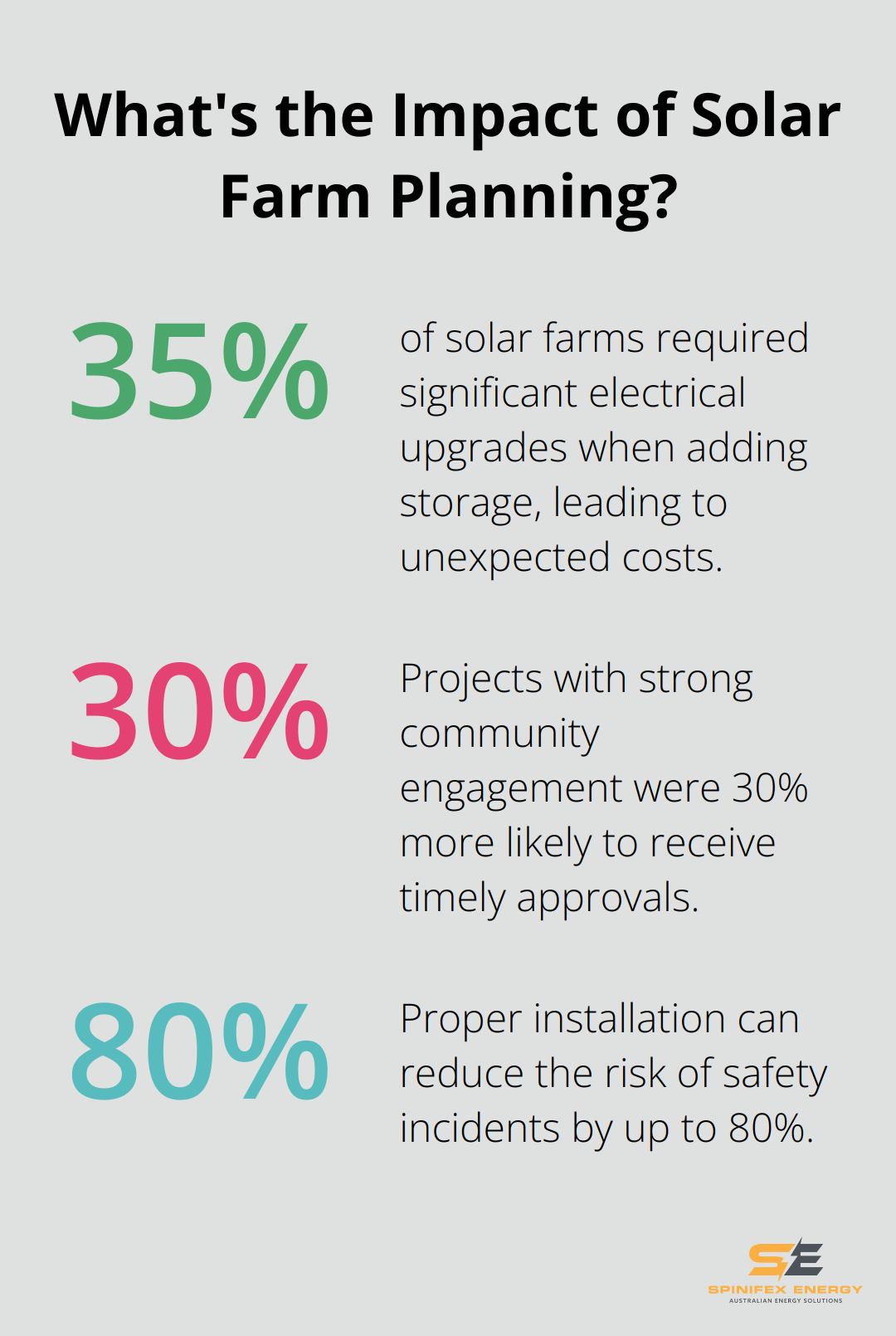Solar farm battery storage is revolutionizing the renewable energy landscape. This technology allows solar farms to store excess energy for use during periods of low sunlight or high demand.
At Spinifex Energy, we’ve seen firsthand how battery storage systems can significantly boost the efficiency and profitability of solar farms. In this post, we’ll guide you through the process of implementing battery storage in your solar farm, from understanding its benefits to key considerations and practical steps for successful integration.
Why Battery Storage Transforms Solar Farms
Boosting Grid Stability
Battery storage revolutionizes solar farms by stabilizing the power grid. Solar energy production fluctuates due to weather conditions and the day-night cycle. Battery systems smooth out these fluctuations by storing excess energy during peak production times and releasing it when needed. This capability maintains a consistent power supply, reduces strain on the grid, and minimizes the risk of blackouts or brownouts.
Maximizing Energy Utilization
Battery storage allows solar farms to capture and use every kilowatt-hour of energy they produce. Without storage, excess energy generated during peak sunlight hours might go to waste if it exceeds grid demand. Batteries store this surplus for later use, significantly increasing the overall energy utilization of the solar farm.
Enhancing Revenue Streams
The financial benefits of integrating battery storage into solar farms are substantial. Solar farm operators can take advantage of time-of-use pricing and maximize their revenue by storing energy and selling it during periods of high demand. This strategy (known as energy arbitrage) allows operators to sell stored energy when prices peak, rather than being limited to selling only when the sun shines.

Battery storage also opens up new revenue streams through ancillary services. Solar farms with storage can participate in frequency regulation markets, capacity markets, and other grid services that were previously inaccessible to variable renewable energy sources.
Future-Proofing Solar Investments
Implementing battery storage in solar farms doesn’t just improve current operations; it future-proofs investments. As the energy landscape evolves, solar farms equipped with storage will adapt better to new market opportunities and regulatory changes.
The integration of battery storage systems into solar farms marks a significant leap forward in renewable energy technology. These advancements pave the way for more efficient and profitable solar operations. In the next section, we’ll explore the key considerations for successfully implementing battery storage in your solar farm.
Mastering Battery Storage Implementation for Solar Farms
Selecting the Optimal Battery Technology
The foundation of successful battery storage implementation lies in choosing the right technology. Lithium-ion batteries currently lead the market due to their high energy density, extended cycle life, and decreasing costs. However, alternative options like flow batteries or sodium-sulfur batteries might suit specific applications better.

When selecting a battery technology, evaluate these key factors:
- Cycle life: The number of charge-discharge cycles before significant degradation
- Depth of discharge: The usable percentage of battery capacity without lifespan impact
- Response time: The speed at which the battery reacts to grid demands
- Environmental performance: The battery’s ability to function optimally in local climate conditions
For instance, flow batteries excel in scenarios requiring frequent deep discharges, as they can handle 100% depth of discharge without degradation. Conversely, lithium-ion batteries prove superior for rapid response to grid fluctuations.
Determining Optimal System Size and Capacity
The size and capacity of your battery storage system directly impact your return on investment (ROI). This determination process involves a thorough analysis of your solar farm’s generation profile, local grid demands, and potential revenue streams.
Consider these critical factors:
- Peak solar generation: The maximum excess energy your farm produces
- Required storage duration: Short-term for grid stabilization or long-term for energy arbitrage
- Grid connection capacity: The maximum power you can feed into the grid
- Local energy market dynamics: Peak pricing periods in your area
Many solar farm operators initially underestimate their storage needs. A common pitfall involves sizing the battery system based solely on current requirements, without accounting for future expansion or evolving market conditions. It often proves more cost-effective to slightly oversize the initial installation to accommodate future growth.
Integrating with Existing Infrastructure
Successful integration of a battery storage system with an existing solar farm demands meticulous planning to ensure compatibility and optimal performance. This process encompasses both physical and digital integration aspects.
Physical integration considerations include:
- Space availability: Adequate room for battery containers and associated equipment
- Electrical infrastructure compatibility: Current inverter system’s suitability for battery storage or the need for additional inverters
- Thermal management: Strategies for managing heat generation from the batteries
Digital integration plays an equally crucial role. Your battery management system (BMS) must communicate effectively with your solar farm’s control systems and the grid operator. This integration enables intelligent energy management features such as:
- Predictive charging based on weather forecasts
- Automated participation in energy markets
- Real-time adjustments to grid demands
Proper integration can significantly boost a solar farm’s performance.
As you move forward with your battery storage implementation plan, the next critical step involves conducting a comprehensive site assessment. This evaluation will provide valuable insights into your specific solar farm’s needs and potential challenges, ensuring a smooth and successful integration process.
How to Implement Battery Storage in Your Solar Farm
Conduct a Thorough Site Assessment
The first step to implement battery storage is a comprehensive site assessment. This evaluation analyzes your solar farm’s current performance, identifies potential bottlenecks, and determines the optimal location for your storage system.

Collect at least 12 months of historical data on your solar farm’s energy production and consumption patterns. This data will help you accurately size your battery system and predict its impact on your operations.
Assess your site’s electrical infrastructure. Many solar farms underestimate the upgrades needed to accommodate battery storage. A 2024 report by the National Renewable Energy Laboratory found that 35% of solar farms required significant electrical upgrades when adding storage, leading to unexpected costs.
Navigate the Permit and Approval Process
Obtaining the necessary permits and approvals can be one of the most time-consuming aspects of implementing battery storage. The specific requirements vary by location, but generally include environmental impact assessments, fire safety plans, and grid connection agreements.
Start this process early. The permitting process can take anywhere from 3 to 18 months, depending on your location and project size. Proactively engage with local authorities and utility companies to speed up this process.
Don’t overlook community engagement. Host information sessions for local residents to address concerns and smooth the approval process. A study by the Solar Energy Industries Association found that projects with strong community engagement were 30% more likely to receive timely approvals.
Design and Install Your Battery System
The design phase is where your earlier planning pays off. Work with experienced engineers to create a system that meets your current needs and allows for future expansion. The U.S. Energy Information Administration expects solar-plus-storage installations to grow by 300% over the next five years, so future-proofing your design is important.
When it comes to installation, prioritize safety. Ensure your installation team is certified and follows all relevant safety standards. The Energy Storage Association reports that proper installation can reduce the risk of safety incidents by up to 80%.
Pay close attention to the integration of your battery management system (BMS) with your existing solar farm control systems. This integration is key to optimize performance and unlock new revenue streams (like frequency regulation or demand response programs).
Optimize System Performance
After installation, focus on optimizing your battery storage system’s performance. This involves fine-tuning your energy management strategies and regularly monitoring system efficiency.
Implement predictive analytics to forecast energy production and demand. This allows you to optimize charging and discharging cycles, maximizing the value of your stored energy.
Regularly update your battery management software to ensure you’re taking advantage of the latest features and improvements. Many battery manufacturers offer remote monitoring and optimization services to help you get the most out of your system.
Final Thoughts
Solar farm battery storage transforms renewable energy operations. It stabilizes the grid, maximizes energy utilization, and opens new revenue streams for solar farms. The future of solar-plus-storage systems looks promising as technology advances and costs decrease (we expect widespread adoption across the industry).

Successful implementation of battery storage in solar farms requires careful planning and expertise. The complexities of system sizing, technology selection, and integration with existing infrastructure highlight the importance of professional consultation. At Spinifex Energy, we provide tailored energy solutions, including advanced commercial solar power systems and innovative battery storage solutions.
Solar farm operators who embrace battery storage technology will position themselves to thrive in the evolving renewable energy landscape. This transformative step can unlock unprecedented value and contribute significantly to a more sustainable energy ecosystem. With the right guidance and expertise, implementing battery storage in your solar farm can lead to substantial benefits for your operations and the environment.

